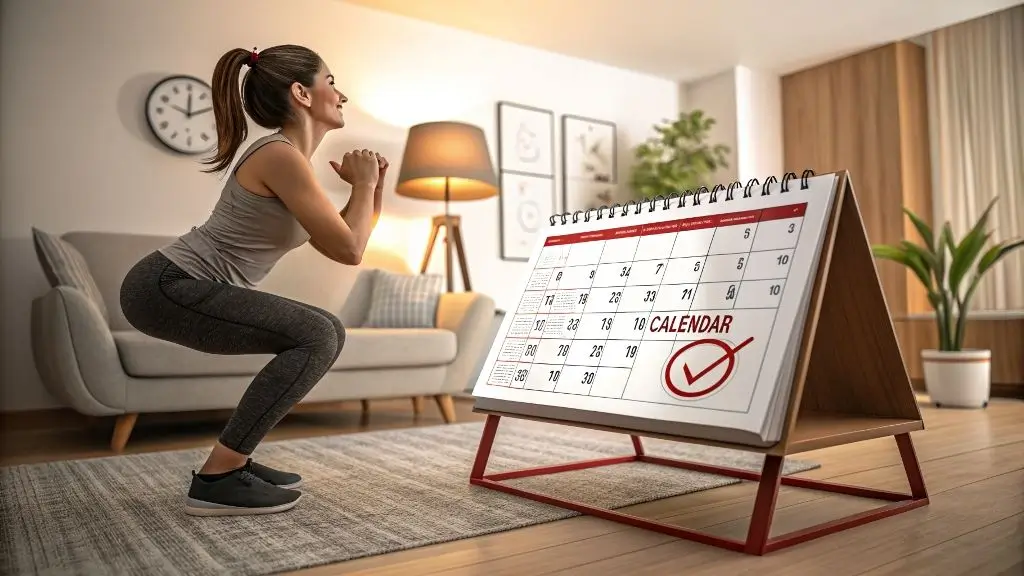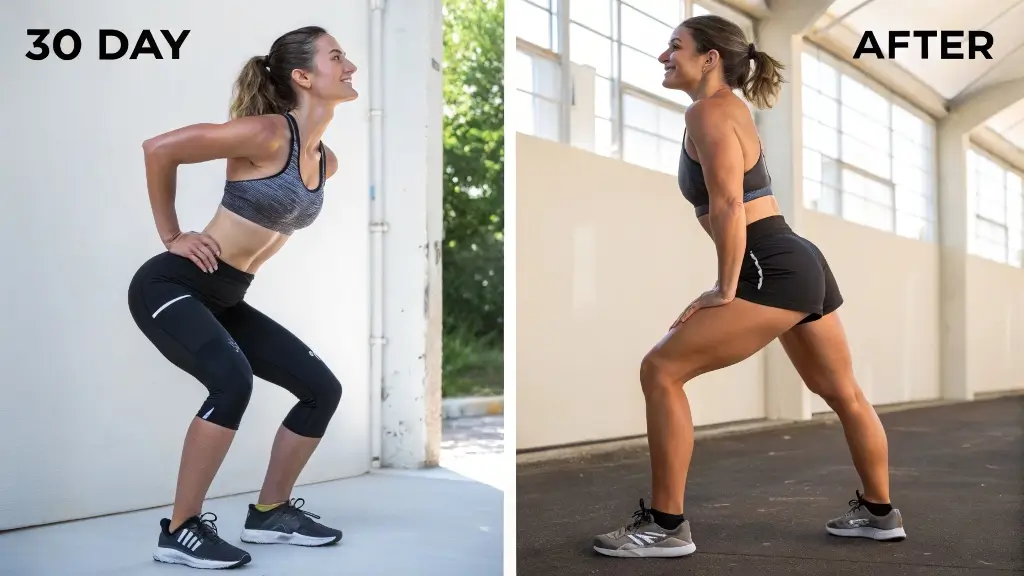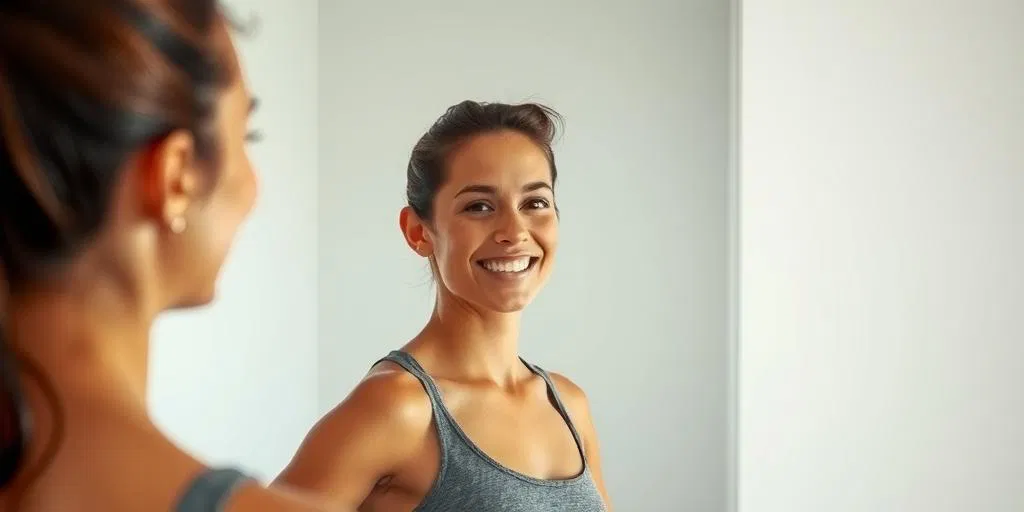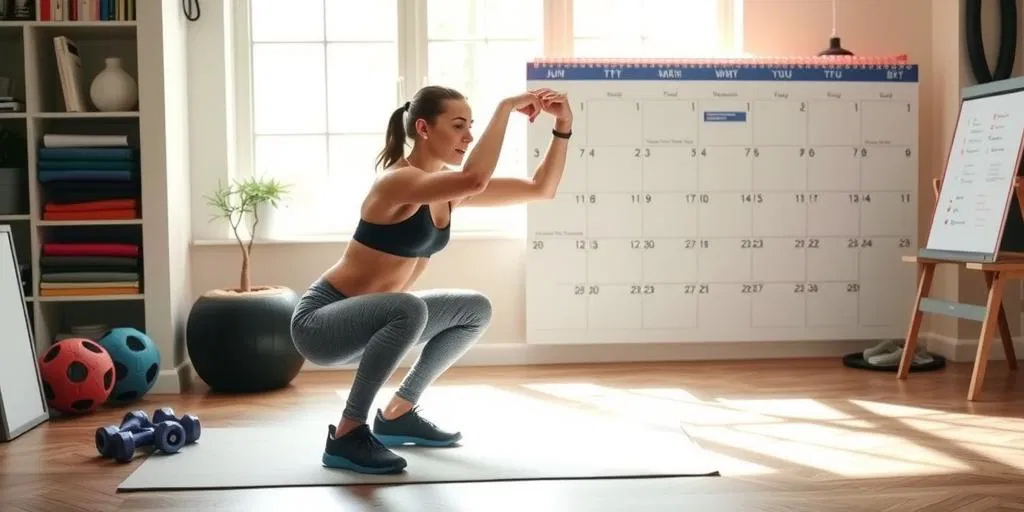The 30-Day Squat Challenge: How This Simple Commitment Can Transform More Than Just Your Glutes
Ready to build strength, boost confidence, and kickstart a powerful new habit? Discover the surprising benefits of dedicating a month to the mighty squat.

My gym subscription ended as summer approached. I didn’t renew it but still wanted to stay fit, so I searched for simple exercises I could do at home without equipment. That’s when I stumbled upon the 30-day squat challenge.
At first, it seemed too simple – just do squats every day for a month? But as I researched, I discovered this challenge was more than just a quick fitness fix. It represented a powerful tool for physical and mental transformation when approached correctly.
In this article, I’ll explore not only the physical benefits you’d expect from squats but also the often-overlooked psychological gains and strategies to leverage this challenge for building lasting healthy habits.
Why Squats? Why 30 Days?

The squat stands as one of the most effective compound exercises in existence. When performed correctly, this functional exercise boosts calorie burn, helps prevent injuries, strengthens your core, and improves balance and posture.
Unlike isolated movements that target single muscle groups, squats engage multiple major muscles simultaneously, primarily your glutes, quadriceps, hamstrings, and core.
Squatting features components of everyday functional movements such as walking, ascending and descending stairs, sitting down, and standing up. This functional nature means squats translate directly to improved mobility in daily life.
By strengthening these movement patterns, you’re not just building aesthetic muscle – you’re investing in injury prevention and longevity.
“The squat is such a popular strength movement as it involves several muscles and joints working together,” explains personal trainer Sam McGowan. “There are only a few compound movements that have such an effect.”
The Psychology of a 30-Day Commitment
But, why commit to 30 days specifically?
Let me explain: It’s the sweet spot of challenge duration – long enough to see tangible results but short enough to maintain motivation throughout.
Perhaps the most underestimated benefit of doing the 30-day system is gaining an incredible sense of “self-efficacy” – our belief in our ability to do things. As you progress through a squat challenge, you develop confidence in your capacity to stick with something challenging and see it through.
Research suggests that while the old “21 days to form a habit” wisdom isn’t quite accurate (it actually takes closer to 66 days on average), a 30-day challenge provides an excellent foundation. 30-day challenges are great for trying new things and exploring possibilities, whereas habit formation helps shape behavior in precise ways.
“But what if I can’t even do proper squats to begin with?”
Don’t worry – this challenge can be modified for all fitness levels, which we’ll cover later. Remember, the goal isn’t perfection on day one but progress by day thirty.
Expected Physical Transformations

Muscle Toning and Strength
The most obvious benefit of the squat challenge is increased lower body strength and muscle tone. Squat workouts effectively tone lower body muscles, engage abdominal muscles, and improve core strength. They’re especially effective at targeting the gluteus maximus, medius, and minimus (your butt muscles), quadriceps (front thigh), hamstrings (back thigh), and calves.
Managing expectations is crucial here. In 30 days, you won’t transform completely, but you’ll definitely notice improvements. After completing a 30-day squat challenge, many participants report their thighs feeling stronger with reduced “bottom jiggle” and a small endorphin rush after each session.
Improved Posture and Stability
Beyond aesthetic benefits, the 30-day squat challenge can significantly improve your posture. The squat improves core strength by strengthening muscles around your stomach and lower back, which helps with proper posture.
Balance is another unexpected benefit. Balance is underrated but crucial as we age to reduce mobility issues. Good balance is a strong indicator of overall brain health. The stabilizing muscles developed through regular squatting contribute to better equilibrium in daily movements.
Caloric Burn and Fat Loss Contribution
While squats alone won’t melt away body fat, they contribute significantly to your overall calorie expenditure. Research by Harvard Medical School found that 30 minutes of weightlifting (such as squats) can burn between 90 to 126 calories, while vigorous weightlifting can burn up to 252 calories.
As a compound exercise, squats recruit multiple large muscle groups, requiring more energy and thus burning more calories than isolated exercises. For best fat loss results, weighted variations eventually become more effective than bodyweight alone.
Form First: The Foundation of Results
(Ed. note: This section cannot be emphasized enough—proper form prevents injury and ensures results!)
Before discussing variations or scheduling, let’s address the cornerstone of squat success: proper form. To start, stand with your feet hip-width apart, toes pointing forward slightly. With your chest up and core braced, push your hips back as you lower yourself as if sitting in an invisible chair.
Common form mistakes include:
- Allowing knees to cave inward
- Lifting heels off the ground
- Rounding the lower back
- Not going deep enough
Personal trainer Andrea Tam stresses that “improper squats can definitely lead to lower-back and knee injuries. Form is so important with every exercise. I stress that in all of my teachings, form over everything.”
Beyond the Physical: The Unexpected Wins

Boosting Confidence and Self-Efficacy
While toned glutes might be the initial goal, many challenge participants discover mental benefits that outlast physical changes. Committing to a 30-day challenge provides the boost needed to start making a change, builds momentum through daily repetition, and creates small successes that help motivate continued progress.
This confidence often extends beyond fitness. Proving to yourself that you can commit to something challenging for 30 days creates a powerful mental template for tackling other life challenges.
Increased Body Awareness
The mind-muscle connection developed through consistent squatting heightens overall body awareness. Squat variations target different muscles, muscle fibers, and movement patterns, helping your body become stronger and more resistant to injury.
This improved proprioception = greater coordination and control in all physical activities.
Stress Relief and Mood Improvement
Exercise is a proven mood enhancer, and the squat challenge is no exception. Many participants report getting “a little endorphin rush straight after too, which helped with my mood and productivity.”
The meditative aspect of focused exercise provides a mental break from daily stress. Counting reps, focusing on form, and being present in your body offers a mental vacation from worries and obligations.
Kickstarting a Healthier Lifestyle
Perhaps most valuable is how the challenge can serve as a gateway to broader health changes. 30-day challenges allow you to build confidence and momentum moving forward with a habit that may become part of your long-term lifestyle.
Success breeds success. Once you’ve proven to yourself you can complete a 30-day challenge, other health goals suddenly seem more achievable.
30-Day Squat Challenge Plan
Transform your lower body strength and endurance with this progressive 30-day squat challenge. Each week builds upon the previous one, with strategic rest days to maximize your results. By the end, you’ll be doing 250 squats – and feeling stronger than ever!
Here’s How The 30 Days Squat Challenge Looks Like:
- 1st Day: Make 50 squats
- 2nd Day: Make 55 squats
- 3rd Day: Make 60 squats
- 4th Day: You need to rest
- 5th Day: Make 70 squats
- 6th Day: Make 75 squats
- 7th Day: Make 80 squats
- 8th Day: You need to rest
- 9th Day: Make 100 squats
- 10th Day: Make 105 squats
- 11th Day: Make 110 squats
- 12th Day: You need to rest
- 13th Day: Make 130 squats
- 14th Day: Make 135 squats
- 15th Day: Make 140 squats
- 16th Day: You need to rest
- 17th Day: Make 150 squats
- 18th Day: Make 155 squats
- 19th Day: Make 160 squats
- 20th Day: You need to rest
- 21st Day: Make 180 squats
- 22nd Day: Make 185 squats
- 23rd Day: Make 190 squats
- 24th Day: You need to rest
- 25th Day: Make 220 squats
- 26th Day: Make 225 squats
- 27th Day: Make 230 squats
- 28th Day: You need to rest
- 29th Day: Make 240 squats
- 30th Day: Make 250 squats
This amazing challenge will help you have the body of your dreams! You’ll be toned and fitter than ever! Rest for several days when you finish the challenge and then you can repeat.
Modifications for Different Fitness Levels
The beauty of the squat challenge lies in its adaptability. Here are modifications for various fitness levels:
| Beginners | Intermediate | Advanced |
|---|---|---|
| Chair squats (using a chair for support) | Full bodyweight squats | Jump squats |
| Half squats (not going to full depth) | Pulse squats | Weighted squats (holding dumbbells or kettlebells) |
| Wall squats (with back against wall) | Sumo squats (wide stance) | Single-leg squat variations |
Some 30-day squat challenges incorporate these variations directly, suggesting side squats on some days, narrow squats on others, and pulse squats as you progress.
From Challenge to Lifestyle – The Missing Link in Most Guides

The Post-Challenge Plateau
Many 30-day challenge guides focus exclusively on getting through the month without addressing what comes next. This oversight often leads to participants completely stopping their progress and losing gains.
According to fitness experts, after about four weeks of using the same exercises, your glutes will adapt to the routine and stop growing. At that point, you need to switch up the exercises to provide a new muscle-building stimulus.
Integrating Squats into a Sustainable Routine
Rather than seeing day thirty as an endpoint, view it as a transition to a sustainable exercise routine. Instead of doing daily squats, giving your muscles time to rest between leg sessions that include squats is best. As a rule of thumb, take at least a day off between squat-heavy workouts, or train other muscle groups like upper body or core.
A sustainable approach might include:
- Squats 2-3 times per week (rather than daily)
- Varied intensity and rep schemes
- Progressive overload (gradually increasing difficulty)
- Complementary exercises for balanced development
Leveraging the Discipline Gained
The mental fortitude built during your 30-day challenge is transferable capital. As you make progress on various 30-day challenges, you’ll notice you start to have true belief in your ability to grow, with the only limit being the pace of your growth.
This newfound discipline can be applied to other health goals like nutrition changes, sleep improvements, or stress management techniques.
The “Challenge Mindset” vs. “Lifestyle Mindset”
The shift from short-term challenge thinking to long-term lifestyle mindset represents the difference between temporary change and lasting transformation. While 30-day challenges are excellent for exploring new possibilities, purposeful habit formation shapes behavior and life in precise ways.
The challenge mindset asks: “Can I do this for 30 days?” The lifestyle mindset asks: “How can I make this sustainable forever?”
Potential Pitfalls and How to Navigate Them
- Risk of Injury with Improper Form – The greatest risk in any squat challenge is injury from poor technique. Just like other exercises, if you don’t have the correct form with squats, you won’t reap the benefits for muscle development and can result in injuries.
- Overtraining or Burnout – While consistency is key, there’s a fine line between dedication and overtraining. Some challenges don’t include proper warm-up and cool-down periods. These exercises help safely increase your heartbeat and then safely slow it down. Studies show including a warm-up can help relieve muscle soreness.
- Unrealistic Expectations – Social media before-and-after transformations often create unrealistic expectations. “In terms of seeing visible results, you really need to factor in eating habits,” says trainer Andrea Tam. “If you are eating healthy, exercising daily, then you should see some positive results in the glutes within 30 days. But if you are exercising, have added 50 squats a day but continue to eat unhealthy foods, then that will definitely hinder your results.”
- The Importance of a Holistic Approach – While the squat challenge focuses on one exercise, overall health requires a multifaceted approach. While a squat challenge will build your glutes, thighs, and hamstrings, it neglects the upper body and core.
- Staying Motivated – Adherence is the greatest predictor of success in any fitness program. Many find it easiest to “bang them out right away – just wake up and get them done” rather than trying to fit them in later.
Bottom Line
The 30-day squat challenge is more than just a month of lower-body exercise – it’s a way to prove to yourself what’s possible through consistency and focused effort.
By committing to this simple daily practice, you’re building not just stronger legs but a stronger mindset. The discipline, self-efficacy, and sense of accomplishment gained often ripple into other areas of life.
Whether your goal is aesthetic improvement, functional strength, or simply establishing a consistent exercise habit, the squat challenge offers an accessible entry point requiring minimal time and no equipment.
“But will I really stick with it? I’ve tried challenges before and given up.“
This time can be different. By understanding both the physical mechanics and psychological principles behind successful habit formation, you’re already ahead of where you were before. Start small, focus on form, celebrate daily wins, and remember that this challenge isn’t just about what your body looks like—it’s about what your mind becomes capable of.
Are you ready to take control of your fitness and well-being, one squat at a time? The next 30 days could change more than just your glutes—they could change your relationship with exercise and personal achievement for years to come.
Have you tried a 30-day fitness challenge before? Share your experiences in the comments section below.
